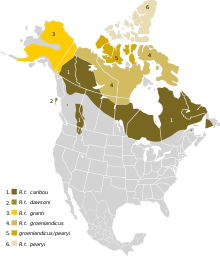Caribou (North America)
| Caribou/reindeer (North America) | |
|---|---|
 |
|
| Male Porcupine caribou R. t. granti in Alaska | |
| Scientific classification | |
| Kingdom: | Animalia |
| Phylum: | Chordata |
| Class: | Mammalia |
| Order: | Artiodactyla |
| Family: | Cervidae |
| Subfamily: | Capreolinae |
| Genus: |
Rangifer C.H. Smith, 1827 |
| Species: | R. tarandus |
| Binomial name | |
|
Rangifer tarandus (Linnaeus, 1758) |
|
| Subspecies in North America | |
Also see text |
|
 |
|
| Approximate range of barren-ground caribou. Overlap with other subspecies of caribou is possible for contiguous range. 1.Rangifer tarandus caribou subdivided into ecotypes: boreal woodland; migratory woodland; montane woodland; 2. Queen Charlotte Islands (extinct 1907); 3. Porcupine; 4. barren-ground; 5. Peary | |
| Synonyms | |
|
reindeer in Europe and Eurasia |
|
Also see text
reindeer in Europe and Eurasia
A caribou (Rangifer tarandus caribou, and other trinomials under Rangifer tarandus) is any of several North American subspecies, ecotypes, populations, and herds of the species Rangifer tarandus, or reindeer. In North America caribou vary in size from the smallest, the Peary caribou, to the largest, the boreal woodland caribou. The North American range of caribou extends from Alaska, through the Yukon, the Northwest Territories, Nunavut, into the boreal forest and south through the Canadian Rockies and the Columbia and Selkirk Mountains. Barren-ground, Porcupine caribou and Peary caribou live in the tundra, while the shy woodland caribou prefers the boreal forest. Two major subspecies in North America, the Porcupine caribou and the barren-ground caribou, form large herds and undertake lengthy seasonal migrations from birthing grounds, to summer and winter feeding grounds in the tundra and taiga. The migrations of Porcupine caribou herds are among the longest of any terrestrial mammal. Barren-ground caribou are also found in Kitaa in Greenland, but the larger herds are in Alaska, the Northwest Territories, and Nunavut.
The circumpolar species itself, Rangifer tarandus, at a global level, is listed by the International Union for Conservation of Nature (ICUN) as vulnerable "due to an observed 40% decline over three generations (about 21–27 years) across the circum-Arctic countries, when Rangifer declined from about 4,800,000 to 2,890,410 individuals." The populations of subspecies, ecotypes, populations and herds of caribou in North America are in decline and one subspecies, the iconic boreal woodland caribou, has been listed by COSEWIC as threatened since 2002.
...
Wikipedia

